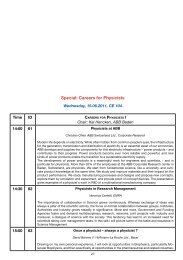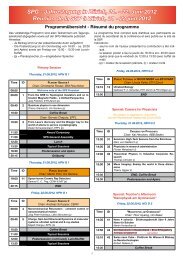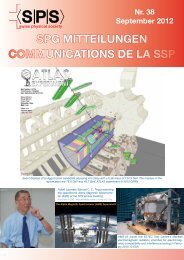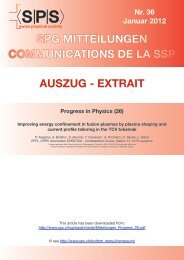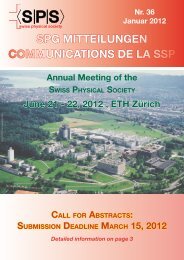spg mitteilungen communications de la ssp - Schweizerische ...
spg mitteilungen communications de la ssp - Schweizerische ...
spg mitteilungen communications de la ssp - Schweizerische ...
Create successful ePaper yourself
Turn your PDF publications into a flip-book with our unique Google optimized e-Paper software.
SPG Mitteilungen Nr. 40<br />
First result from the AMS experiment<br />
Martin Pohl, Center for Astroparticle Physics, CAP Genève<br />
Beginning of April 2013, the Alpha Magnetic Spectrometer<br />
(AMS) Col<strong>la</strong>boration published its first physics result in<br />
Physical Review Letters 1 . The AMS experiment is a powerful<br />
and sensitive particle physics spectrometer. As seen in<br />
Figure 1, AMS is located on the exterior of the International<br />
Space Station (ISS). Since its instal<strong>la</strong>tion on 19 May 2011 it<br />
has measured over 30 billion cosmic rays in the GeV to TeV<br />
energy range. Its permanent magnet and array of precision<br />
particle <strong>de</strong>tectors collect and i<strong>de</strong>ntify charged cosmic rays<br />
passing through. Over its long duration mission on the ISS,<br />
AMS will record signals from 16 billion cosmic rays every<br />
year and transmit them to Earth for analysis by the AMS<br />
Col<strong>la</strong>boration. This is the first of many physics results to be<br />
reported.<br />
onboard the final mission of space shuttle En<strong>de</strong>avour (STS-<br />
134) on 16 May 2011. Once installed on 19 May 2011, AMS<br />
was powered up and immediately began collecting data<br />
from primary sources in space and these were transmitted<br />
to the AMS Payload Operations Control Center located at<br />
CERN, Geneva, Switzer<strong>la</strong>nd.<br />
Once AMS became operational, the first task for the AMS<br />
Col<strong>la</strong>boration was to ensure that all instruments and systems<br />
performed as <strong>de</strong>signed and as tested on the ground.<br />
The AMS <strong>de</strong>tector, with its multiple redundancies, has proven<br />
to perform f<strong>la</strong>wlessly in space. Over the <strong>la</strong>st 22 months in<br />
flight, AMS col<strong>la</strong>borators have gained invaluable operational<br />
experience in running a precision spectrometer in space<br />
and mitigating the hazardous conditions to which AMS is<br />
exposed as it orbits the Earth every 90 minutes. Conditions<br />
like this are not encountered by ground-based accelerator<br />
experiments or satellite-based experiments and require<br />
constant vigi<strong>la</strong>nce in or<strong>de</strong>r to avoid irreparable damage.<br />
They inclu<strong>de</strong> the extreme thermal variations caused by so<strong>la</strong>r<br />
effects and the re-positioning of ISS onboard radiators<br />
and so<strong>la</strong>r arrays. In addition, the AMS operators regu<strong>la</strong>rly<br />
transmit software updates from the AMS POCC at CERN to<br />
the AMS computers in space in or<strong>de</strong>r to match the regu<strong>la</strong>r<br />
upgra<strong>de</strong>s of the ISS software and hardware.<br />
Figure 1: From its vantage point about 400 km above the Earth, the<br />
Alpha Magnetic Spectrometer (AMS) collects data from primordial<br />
cosmic rays that traverse the <strong>de</strong>tector.<br />
The first publication from the AMS Experiment is a major<br />
milestone for the AMS international col<strong>la</strong>boration. Hundreds<br />
of scientists, engineers, technicians and stu<strong>de</strong>nts from all<br />
over the world have worked together for over 18 years to<br />
make AMS a reality. The col<strong>la</strong>boration represents 16 countries<br />
from Europe, Asia and North America (Fin<strong>la</strong>nd, France,<br />
Germany, Italy, the Nether<strong>la</strong>nds, Portugal, Spain, Switzer<strong>la</strong>nd,<br />
Romania, Russia, Turkey, China, Korea, Taiwan, Mexico<br />
and the United States) un<strong>de</strong>r the lea<strong>de</strong>rship of Nobel<br />
Laureate Samuel Ting of M.I.T. The col<strong>la</strong>boration continues<br />
to work closely with the NASA AMS Project Management<br />
team from Johnson Space Center as it has throughout the<br />
entire process. Many countries have ma<strong>de</strong> important contributions<br />
to the AMS <strong>de</strong>tector construction and presently<br />
to the data analysis. These inclu<strong>de</strong> two groups from Switzer<strong>la</strong>nd,<br />
University of Geneva and ETHZ, supported by fe<strong>de</strong>ral<br />
and cantonal authorities as well as the SNF.<br />
AMS was constructed at universities and research institutes<br />
around the world and assembled at the European Organization<br />
for Nuclear Research, CERN, Geneva, Switzer<strong>la</strong>nd.<br />
It was <strong>la</strong>unched by NASA to the ISS as the primary payload<br />
1 AMS Col<strong>la</strong>boration, M. Agui<strong>la</strong>r et al., First Result from the Alpha<br />
Magnetic Spectrometer on the International Space Station: Precision<br />
Measurement of the Positron Fraction in Primary Cosmic Rays of 0.5–350<br />
GeV, Phys. Rev. Lett. 110, 141102 (2013)<br />
28<br />
Positron fraction measurement<br />
In the initial 18 months period of space operations, from<br />
19 May 2011 to 10 December 2012, AMS analyzed 25 billion<br />
primary cosmic ray events. Of these, an unprece<strong>de</strong>nted<br />
number, 6.8 million, were unambiguously i<strong>de</strong>ntified as<br />
electrons and their antimatter counterpart, positrons. The<br />
6.8 million particles observed in the energy range 0.5 to<br />
350 GeV are the subject of the precision study reported in<br />
this first paper.<br />
Electrons and positrons are i<strong>de</strong>ntified by the accurate and<br />
redundant measurements provi<strong>de</strong>d by the various AMS instruments<br />
against a <strong>la</strong>rge background of protons. Positrons<br />
are clearly distinguished from this background through the<br />
robust rejection power of AMS of more than one in one million.<br />
Currently, the total number of positrons i<strong>de</strong>ntified by AMS,<br />
in excess of 400,000, is the <strong>la</strong>rgest number of energetic<br />
antimatter particles directly measured and analyzed from<br />
space. The first paper can be summarized as follows:<br />
AMS has measured the positron fraction (ratio of the positron<br />
flux to the combined flux of positrons and electrons)<br />
in the energy range 0.5 to 350 GeV. We have observed that<br />
from 0.5 to 10 GeV, the fraction <strong>de</strong>creases with increasing<br />
energy. The fraction then increases steadily between 10<br />
GeV to ~250 GeV. Yet the slope (rate of growth) of the positron<br />
fraction <strong>de</strong>creases by an or<strong>de</strong>r of magnitu<strong>de</strong> from 20 to<br />
250 GeV. At energies above 250 GeV, the spectrum appears<br />
to f<strong>la</strong>tten but to study the behavior above 250 GeV requires<br />
more statistics – the data reported represents ~10% of the





